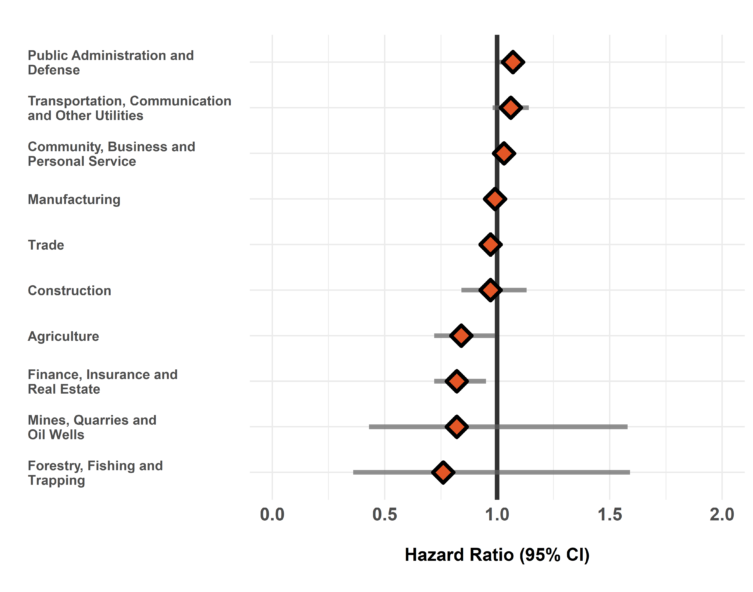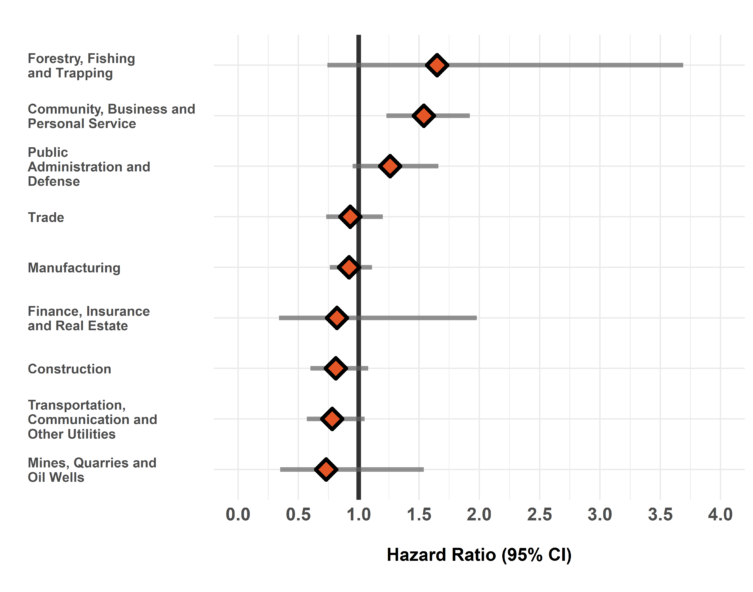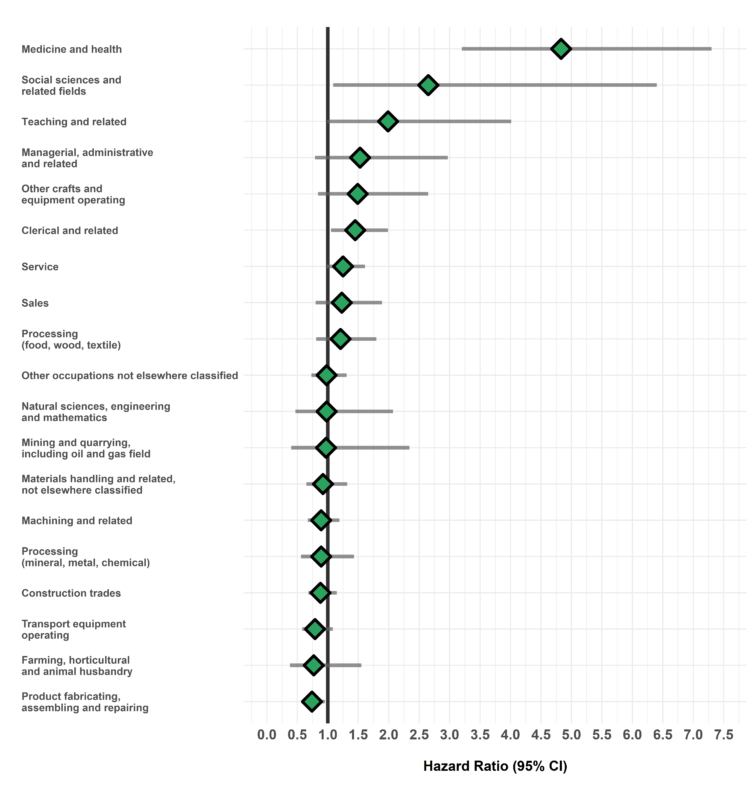Breast Cancer
Background
Breast cancer is the most commonly diagnosed cancer in women, but accounts for less than 1% of cancer cases in men worldwide [1]. There is strong evidence linking female breast cancer to estrogen (e.g. hormone therapy, early menarche, late menopause, few pregnancies), obesity and physical inactivity, and alcohol consumption, but much less is known about potential occupational risk factors. Research on potential occupational risk factors for breast cancer has generally focused on exposure to some organic solvents and pesticides, polychlorinated biphenyls (PCBs), and shift work. Endocrine disrupting agents are suspected due to the role of hormones in breast cancer. Most evidence regarding breast cancer risk factors is based on female breast cancer due to the rarity of the disease among males. There have been few studies of occupational risk factors for male breast cancer and results have been somewhat inconsistent, but insights regarding occupational risk factors could impact both women and men.
Known occupational risk factors
-
- Exposure to x- and gamma-radiation [2]
Possible occupational risk factors
-
- Night shift work [2]
- Endocrine disrupting compounds (e.g. certain pesticides such as dieldrin, polychlorinated biphenyls (PCBs), plastic and rubber byproducts) [1,3,4]
- Ethylene oxide [2]
- Polycyclic aromatic hydrocarbons (PAHs) [3]
- Organic solvents [5]
Key Findings
Increased risks of breast cancer were observed among both women and men for some occupational groups in the ODSS, which suggests a role for work-related risk factors in breast cancer etiology.
Nursing and other health workers
 Elevated risks of breast cancer have previously been observed in workers involved in night or rotating shift work, including nurses [3]. Increased risk of breast cancer was observed among both male and female nurses in the ODSS. Health care workers such as radiological technicians may be exposed to x-ray and gamma radiation through medical imaging and radiation treatments [3]. Ethylene oxide, a suspected risk factor for breast cancer, is a chemical used in the sterilization of medical and dental equipment [6].
Elevated risks of breast cancer have previously been observed in workers involved in night or rotating shift work, including nurses [3]. Increased risk of breast cancer was observed among both male and female nurses in the ODSS. Health care workers such as radiological technicians may be exposed to x-ray and gamma radiation through medical imaging and radiation treatments [3]. Ethylene oxide, a suspected risk factor for breast cancer, is a chemical used in the sterilization of medical and dental equipment [6].
-
- Nursing therapy and related assisting occupations: Women: 1.08 times the risk; Men: 4.73 times the risk
- Nurses: Women: 1.19 times the risk; Men: 8.38 times the risk (note: this risk is based on a small number of cases)
- Physiotherapists, occupational and other therapists: Women: 1.59 times the risk; Men: too few cases to report a result
- Other occupations in medicine and health: Women: 1.18 times the risk; Men: 6.50 times the risk
- Radiological technologists and technicians: Women: 1.63 times the risk; Men: too few cases to report a result
- Hospitals: Women: 1.11 times the risk; Men: 2.15 times the risk
- Diagnostic and therapeutic services industry, not elsewhere specified*: Women: 1.35 times the risk; Men: too few cases to report a result
- Nursing therapy and related assisting occupations: Women: 1.08 times the risk; Men: 4.73 times the risk
*This industry includes laboratories (dental, medical, X-ray, etc.) providing analysis, diagnosis or treatment service to the medical or dental professions or to patients on prescription of a physician or dentist, and organizations such as the Victorian Order of Nurses, Red Cross Blood Transfusion Service, and St. John Ambulance.
Air transport
 Risk of breast cancer among airline crew has been of interest because of exposure to cosmic radiation and circadian rhythm disruption [4]. Too few cases were observed among workers in the ODSS to examine this risk among specific occupation groups, or among men, but an increased breast cancer risk was observed among women for the overall industry.
Risk of breast cancer among airline crew has been of interest because of exposure to cosmic radiation and circadian rhythm disruption [4]. Too few cases were observed among workers in the ODSS to examine this risk among specific occupation groups, or among men, but an increased breast cancer risk was observed among women for the overall industry.
-
- Air transport industry: Women: 1.41 times the risk; Men: too few cases to report a result
White collar occupations
 Individuals in these occupations generally have higher income and education, fewer children and work in sedentary jobs, which are characteristics that have been associated with breast cancer among women [7]. Elevated risks were observed among both men and women for many of these occupational groups.
Individuals in these occupations generally have higher income and education, fewer children and work in sedentary jobs, which are characteristics that have been associated with breast cancer among women [7]. Elevated risks were observed among both men and women for many of these occupational groups.
-
- Teaching and related occupations: Women: 1.27 times the risk; Men: 1.99 times the risk
- Managerial, administrative, and related occupations: Women: 1.23 times the risk; Men: 1.53 times the risk
- Clerical and related occupations: Women: 1.10 times the risk; Men: 1.45 times the risk
Relative Risk by Industry and Occupation
Figure 1. Risk of breast cancer diagnosis among female workers employed in each industry group relative to all others, Occupational Disease Surveillance System (ODSS), 1983-2016

Figure 2. Risk of breast cancer diagnosis among male workers employed in each industry group relative to all others, Occupational Disease Surveillance System (ODSS), 1983-2016

Figure 3. Risk of breast cancer diagnosis among female workers employed in each occupation group relative to all others, Occupational Disease Surveillance System (ODSS), 1983-2016

Figure 4. Risk of breast cancer diagnosis among male workers employed in each occupation group relative to all others, Occupational Disease Surveillance System (ODSS), 1983-2016

Table of Results
Table 1. Surveillance of Female Breast Cancer: Number of cases, workers employed, and hazard ratios in each industry (SIC)
| SIC Code * | Industry Group | Number of cases | Number of workers employed | Hazard Ratio (95% CI) † |
| 1 | Agriculture | 147 | 8,652 | 0.84 (0.72-0.99) |
| 2/3 | Forestry, Fishing and Trapping |
7 | 479 | 0.76 (0.36-1.59) |
| 4 | Mines, Quarries and Oil Wells |
9 | 477 | 0.82 (0.43-1.58) |
| 5 | Manufacturing | 4,352 | 164,612 | 0.99 (0.96-1.02) |
| 6 | Construction | 181 | 9,133 | 0.97 (0.84-1.13) |
| 7 | Transportation, Communication and Other Utilities |
728 | 32,888 | 1.06 (0.98-1.14) |
| 8 | Trade | 2,942 | 137,793 | 0.97 (0.93-1.01) |
| 9 | Finance, Insurance and Real Estate |
195 | 8,721 | 0.82 (0.72-0.95) |
| 10 | Community, Business and Personal Service |
8,212 | 348,864 | 1.03 (1.00-1.06) |
| 11 | Public Administration and Defense |
1,685 | 68,996 | 1.07 (1.01-1.12) |
| * SIC: Standard Industrial Classification (1970) | ||||
| † Hazard rate in each group relative to all others | ||||
Table 2. Surveillance of Male Breast Cancer: Number of cases, workers employed, and hazard ratios in each industry (SIC)
| SIC Code * | Industry Group | Number of cases | Number of workers employed | Hazard Ratio (95% CI) † |
| 1 | Agriculture | <5 | 26,340 | — |
| 2/3 | Forestry, Fishing and Trapping |
6 | 10,218 | 1.65 (0.74-3.69) |
| 4 | Mines, Quarries and Oil Wells |
7 | 22,731 | 0.73 (0.35-1.54) |
| 5 | Manufacturing | 175 | 528,600 | 0.92 (0.76-1.11) |
| 6 | Construction | 52 | 201,854 | 0.81 (0.60-1.08) |
| 7 | Transportation, Communication and Other Utilities |
45 | 164,223 | 0.78 (0.57-1.05) |
| 8 | Trade | 74 | 290,946 | 0.93 (0.73-1.20) |
| 9 | Finance, Insurance and Real Estate |
5 | 15,233 | 0.82 (0.34-1.98) |
| 10 | Community, Business and Personal Service |
102 | 249,212 | 1.54 (1.23-1.92) |
| 11 | Public Administration and Defense |
57 | 121,577 | 1.26 (0.95-1.66) |
| * SIC: Standard Industrial Classification (1970) | ||||
| † Hazard rate in each group relative to all others | ||||
Table 3. Surveillance of Female Breast Cancer: Number of cases, workers employed, and hazard ratios in each occupation (CCDO) group
| CCDO Code * | Occupation Group | Number of cases | Number of workers employed | Hazard Ratio (95% CI) † |
| 11 | Managerial, administrative and related |
426 | 16,591 | 1.23 (1.11-1.35) |
| 21 | Natural sciences, engineering and mathematics |
116 | 5,486 | 1.09 (0.91-1.31) |
| 23 | Social sciences and related fields |
486 | 23,761 | 1.14 (1.04-1.24) |
| 25 | Religion | <5 | 72 | – |
| 27 | Teaching and related | 1,117 | 38,139 | 1.27 (1.19-1.35) |
| 31 | Medicine and health | 3,028 | 117,716 | 1.10 (1.05-1.14) |
| 33 | Artistic, literary, recreational and related |
97 | 6,553 | 1.05 (0.86-1.29) |
| 41 | Clerical and related | 2,636 | 100,514 | 1.10 (1.06-1.15) |
| 51 | Sales | 1,480 | 75,966 | 0.96 (0.91-1.01) |
| 61 | Service | 3,977 | 183,060 | 0.89 (0.86-0.92) |
| 71 | Farming, horticultural and animal husbandry |
148 | 10,946 | 0.75 (0.64-0.89) |
| 73 | Fishing, hunting, trapping and related |
<5 | 40 | – |
| 75 | Forestry and logging | <5 | 588 | – |
| 77 | Mining and quarrying, including oil and gas field |
<5 | 148 | – |
| 81 | Processing (mineral, metal, chemical) |
362 | 16,374 | 0.94 (0.84-1.04) |
| 82 | Processing (food, wood, textile) |
733 | 31,854 | 0.95 (0.89-1.03) |
| 83 | Machining and related | 545 | 21,324 | 1.01 (0.93-1.10) |
| 85 | Product fabricating, assembling and repairing |
1,864 | 66,941 | 1.02 (0.97-1.07) |
| 87 | Construction trades | 92 | 4,376 | 1.11 (0.90-1.36) |
| 91 | Transport equipment operating |
306 | 14,142 | 1.05 (0.94-1.18) |
| 93 | Materials handling and related, not elsewhere classified |
823 | 31,050 | 0.99 (0.93-1.06) |
| 95 | Other crafts and equipment operating |
189 | 6,744 | 1.02 (0.89-1.18) |
| 99 | Other occupations not elsewhere classified | 904 | 40,599 | 0.97 (0.91-1.04) |
| * CCDO: Canadian Classification Dictionary of Occupations (1971) | ||||
| † Hazard rate in each group relative to all others | ||||
Table 4. Surveillance of Male Breast Cancer: Number of cases, workers employed, and hazard ratios in each occupation (CCDO) group
| CCDO Code * | Occupation Group | Number of cases | Number of workers employed | Hazard Ratio (95% CI) † |
| 11 | Managerial, administrative and related |
9 | 14,275 | 1.53 (0.79-2.97) |
| 21 | Natural sciences, engineering and mathematics |
7 | 20,834 | 0.98 (0.47-2.07) |
| 23 | Social sciences and related fields |
5 | 6,845 | 2.65 (1.09-6.40) |
| 25 | Religion | 0 | 52 | — |
| 27 | Teaching and related | 8 | 10,058 | 1.99 (0.99-4.01) |
| 31 | Medicine and health | 24 | 17,079 | 4.83 (3.20-7.30) |
| 33 | Artistic, literary, recreational and related |
0 | 8,406 | — |
| 41 | Clerical and related | 42 | 96,347 | 1.45 (1.05-1.99) |
| 51 | Sales | 22 | 71,801 | 1.23 (0.80-1.89) |
| 61 | Service | 73 | 187,246 | 1.25 (0.98-1.61) |
| 71 | Farming, horticultural and animal husbandry |
8 | 39,184 | 0.77 (0.38-1.55) |
| 73 | Fishing, hunting, trapping and related |
0 | 518 | — |
| 75 | Forestry and logging | <5 | 10,094 | — |
| 77 | Mining and quarrying, including oil and gas field |
5 | 12,895 | 0.97 (0.40-2.34) |
| 81 | Processing (mineral, metal, chemical) |
18 | 62,825 | 0.89 (0.56-1.43) |
| 82 | Processing (food, wood, textile) |
25 | 67,316 | 1.21 (0.81-1.80) |
| 83 | Machining and related | 53 | 168,073 | 0.89 (0.67-1.19) |
| 85 | Product fabricating, assembling and repairing |
71 | 261,229 | 0.74 (0.57-0.95) |
| 87 | Construction trades | 65 | 211,243 | 0.88 (0.68-1.15) |
| 91 | Transport equipment operating |
44 | 153,931 | 0.79 (0.58-1.08) |
| 93 | Materials handling and related, not elsewhere classified |
33 | 121,910 | 0.92 (0.65-1.32) |
| 95 | Other crafts and equipment operating |
12 | 21,542 | 1.49 (0.84-2.65) |
| 99 | Other occupations not elsewhere classified | 51 | 174,561 | 0.98 (0.73-1.31) |
| * CCDO: Canadian Classification Dictionary of Occupations (1971) | ||||
| † Hazard rate in each group relative to all others | ||||
Please note that ODSS results shown here may differ from those previously published or presented. This may occur due to changes in case definitions, methodological approaches, and the ongoing nature of the surveillance cohort.
References
- Villeneuve S, Cyr D, Lynge E, Orsi L, Sabroe S, Merletti F, et al. Occupation and occupational exposure to endocrine disrupting chemicals in male breast cancer: a case-control study in Europe. Occup Environ Med. 2010;67(12):837–44.
- International Agency for Research on Cancer (IARC). List of Classifications by cancer sites with sufficient or limited evidence in humans, IARC Monographs Volumes 1-127 (2020).
- Fenga C. Occupational exposure and risk of breast cancer (Review). Biomed Reports. 2016;4(3):282–92.
- Gray JM, Rasanayagam S, Engel C, Rizzo J. State of the evidence 2017: An update on the connection between breast cancer and the environment. Environ Health 2017;16(1):1–61.
- Labrèche F, Kim J, Song C, Pahwa M, Ge CB, Arrandale VH, et al. The current burden of cancer attributable to occupational exposures in Canada. Prev Med. 2019;122:128–39.
- US National Toxicology Program. Report on Carcinogens, Fourteenth Edition: Ethylene oxide. 2016.
- Johnsson A, Broberg P, Johnsson A, Tornberg ÅB, Olsson H. Occupational sedentariness and breast cancer risk. Acta Oncol. 2017;56(1):75–80.
